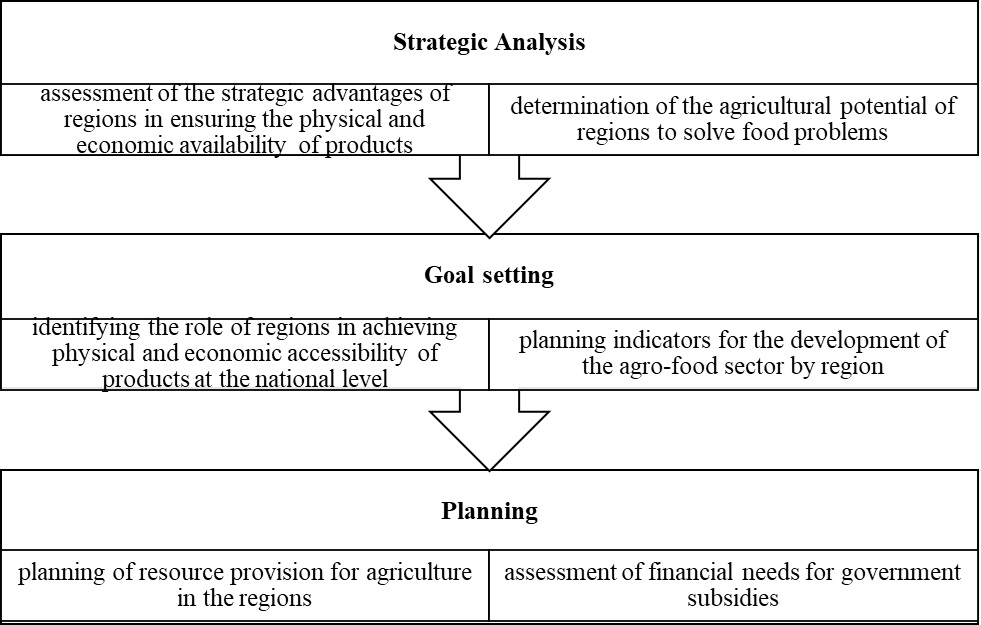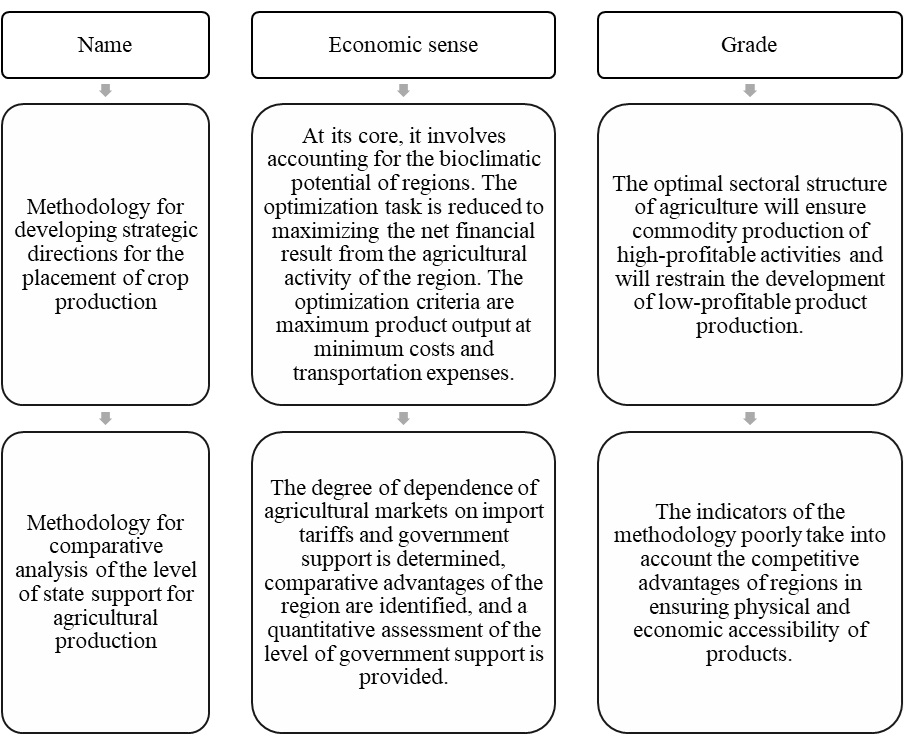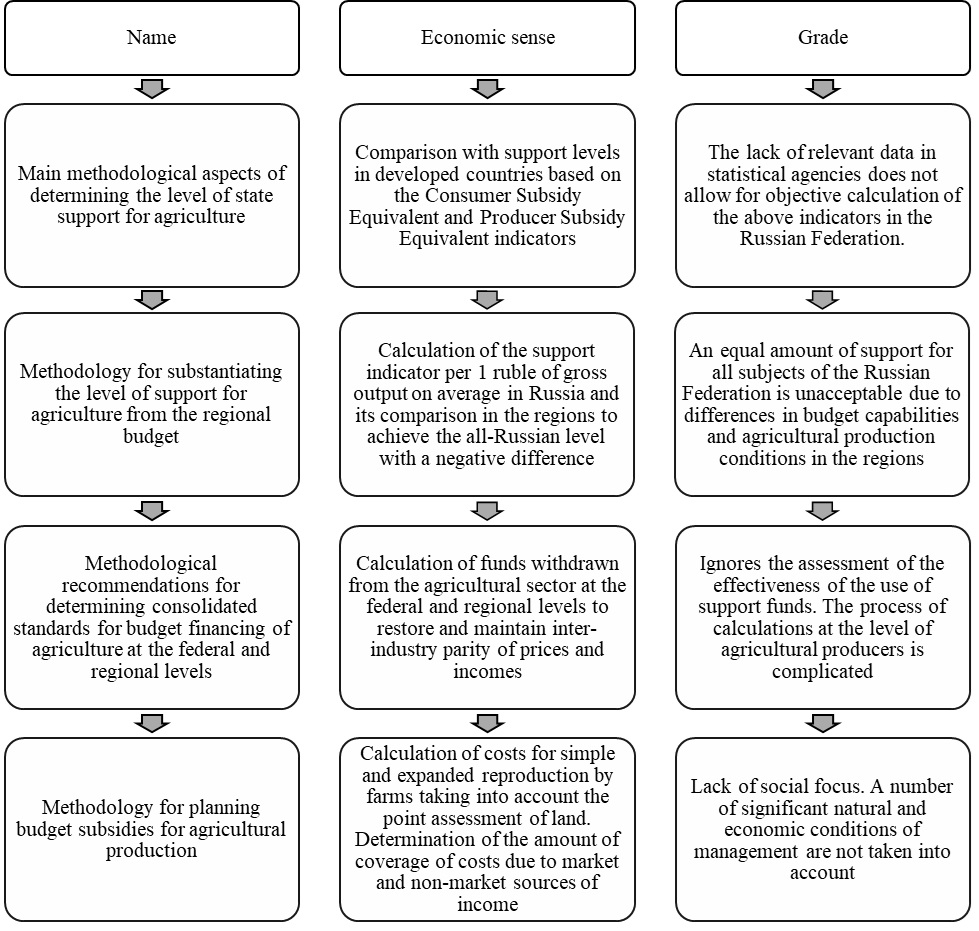Methodological support for the process of strategizing the regional agricultural sector
Methodological support for the process of strategizing the regional agricultural sector
Abstract
The article raises a scientific problem related to the development of tools to support management decisions in the process of strategic planning in the agricultural sector. The objective of the work is to generalize and identify the simulation capabilities of methodological solutions available in science and practice that are suitable for comprehensive support of the process of strategic planning for the development of the regional agri-food sector. The research methodology is based on a critical analysis of a group of various methods, models, techniques and methodological approaches recommended by the scientific community for solving strategic problems (optimization of placement, resource provision, etc.) in agriculture and an assessment of their functional capabilities for comprehensive methodological support of the process of strategic analysis, goal-setting and planning at the territorial level. It is specified that the process of strategizing in the context of ensuring physical and economic availability of products includes strategic analysis, goal-setting and planning of the socio-economic development of the agro-industry. Certain methodological developments have been identified that allow solving individual problems of assessing the effectiveness of territorial placement, optimizing spatial development and planning resource provision for agricultural production. An assessment of their functional capabilities has shown that there are limitations to their comprehensive use in the strategic planning process. In order to improve the level of planning work, it is advisable to strengthen the focus of strategizing tools on ensuring a balance between the physical and economic availability of products.
1. Introduction
Today, the agro-food sector plays a special role in implementing the provisions of the Federal Law "On Strategic Planning in the Russian Federation" in terms of goal-setting, forecasting, planning, and programming of socio-economic development of economic sectors. A significant experience has been accumulated in developing documents and measures for their implementation at the federal and regional levels. First and foremost, this includes the Doctrine of Food Security, the State Program "Development of the Agro-Industrial Complex", two State Programs for Agriculture, and the Strategy for the Development of the Agro-Industrial Complex until 2030. It is worth noting that the program for 2008-2012 was the first to receive the status of a State Program, and the current State Program was a pilot project for adapting project-based planning methods for national economic sectors. In recent years, a certain effectiveness of these documents has been observed. Successes have been achieved in individual areas, sub-sectors, and product types. The achievements of the agricultural business have been mainly due to the reduction of competition against the backdrop of anti-sanctions, the increase in export of products, the growth of internal prices, and so on.
Therefore, it is too early to draw conclusions about the compliance of the level of planned work in the Agro-Industrial Complex with new strategic tasks in ensuring the population's access to affordable products, achieving rational consumption norms, and forming physical and economic accessibility of products. Special discussions , are raised by the annual changes to the structure and content of agricultural programs, including updates and changes to government support measures, frequent adjustments to subsidy provision rules, low balance of goals and resources, and insufficient coordination of development indicators. To enhance the scientific validity of strategic decisions for the development of the Agro-Industrial Complex, it is essential to apply methodological support at each stage of the strategic planning process at the sectoral and territorial levels.
Therefore, the goal of the work is to generalize and identify the simulation capabilities of methodological solutions existing in science and practice, suitable for comprehensive support of the strategic planning process for the development of the agro-food sector in the region.
2. Research methods and principles
The authors of the article argue that to address new strategic challenges in ensuring food security, a new stage of socio-economic development of the agricultural sector is required, involving an increase in production volumes and a simultaneous increase in the purchasing power of the population's income. This is difficult to achieve without additional investments and the correct use of the territorial factor.
Today, according to scientists , , the low levels of investment in the agro-industrial complex (APK), necessary for creating the conditions for the "desired" level of functioning, the existing disproportions, and the increasing differentiation of regions in terms of socio-economic development of agriculture, pose a serious threat to the country's food security. Market regulators without state intervention are unable to find the optimal structure for the placement of agricultural production across regions. Without regional specialization in the production of the most suitable products for the given climatic conditions, it is difficult to ensure the correct use of competitive advantages by goods producers, as not all products can be produced everywhere and with equal efficiency. Moreover, despecialization usually leads only to the scattering of financial resources, a decrease in product output, and an increase in its cost. These problems require scientific justification in the process of strategic planning for the development of the agro-food sector.
Experts' opinions on the composition of elements in the strategic planning process are quite diverse , . Modern research by scientists shows that in the context of territorial planning for the development of the agro-food sector, the key elements of the strategic process are strategic analysis, goal-setting, and planning (Figure 1).
At the stage of strategic analysis, the competitive advantages and agricultural capabilities of the subjects of the Russian Federation in provid.

Figure 1 - Contents of the process of planning strategic development of the agri-food sector
The research methodology is based on a critical analysis of a group of various methods, models, techniques, and methodological approaches recommended by the scientific community for solving strategic tasks (optimization of placement, resource provision, etc.) in agriculture and assessing their functional capabilities for comprehensive methodological support of the strategic analysis, goal-setting, and planning process at the territorial level.
As informational resources, the authors' approaches and methodologies of leading research institutes were studied for evaluating the effectiveness of territorial placement and optimizing spatial development of the Agro-Industrial Complex sectors, as well as for planning subsidies for product manufacturers.
3. Main results
The results of the evaluation of methodological support for solving strategic tasks in agriculture allowed for identifying a sufficient number of scientific developments necessary for accompanying the strategic planning process in the agro-food sphere. All the analyzed methodological support is grouped by categories.
For evaluating the effectiveness and developing proposals for optimizing the territorial placement of agricultural production, there is a set of methodological approaches systematized by authors (Figure 2 and Figure 3).

Figure 2 - Author's approaches to assessing the effectiveness of territorial placement of the agro-industrial complex
Note: compiled by the authors based on [8], [9]

Figure 3 - Methods for assessing the territorial distribution of agricultural production
Note: compiled by the authors based on [10], [11]
In the authors' opinion, at the current stage of Agro-Industrial Complex development and considering the existing situation, the system of indicators for evaluating the effectiveness of territorial placement and optimization criteria should be oriented towards solving a multi-objective task – simultaneously increasing production and economic accessibility of products per capita to rational consumption norms.
Supporting the goal-setting process at the territorial level can be ensured by methodological approaches , based on comparing regional indicators of productivity, sale prices, production costs, effectiveness of government support, and other indicators with average Russian indicators. The revealed comparative advantages of regions can form the methodological basis for optimizing the placement of agricultural production by Russian Federation subjects. The key is to select the necessary system of indicators that takes into account the interests of both business and society when solving national tasks in the sphere of ensuring food security.
To achieve the indicators of agricultural sector development set at the goal-setting stage, corresponding resource support is required. Balancing goals and resources is a key factor in sustainable development of the planning object. Various scientific approaches proposed by their developers can be applied for methodological support of this stage of strategic planning (Figure 4).

Figure 4 - Methodological approaches to planning state support for agriculture
Note: compiled by the authors based on [14], [15], [16], [17]
It is known that the level of prices for products, raw materials, and food should ensure their accessibility not lower than rational consumption norms. However, such a level cannot create conditions for restoring the spent material and technical assets in their previous volume and paying wages to workers commensurate with the average economy-wide level. For this reason, scientists from VNIIESKh rightly raised the question of withdrawing financial resources from agriculture through the "scissors of prices". The proposed methodological recommendations are based on the need to restore financial resources in the agricultural sector, lost due to the inter-industry price disparity for industrial and agricultural products. The calculation methodology is based on the following parameters of "desired" industry development: profitability not lower than the average economy-wide value, labor payment higher than the subsistence minimum by 25% or more, and growth of basic, circulating, and human capital by 5-10%.
According to calculations by well-known RAS academicians , , due to imperfect market relations, agricultural partners in the Agro-Industrial Complex annually "pump out" from the industry through price disparities approximately 0.7 to 1.4 trillion rubles. This is despite the fact that these calculations were made for the period 2013-2017.
The essence of the VNIOPTUSKh (branch of VNIIESKh) methodology is to calculate the norms of expenditures and subsidies necessary for simple or extended reproduction of resources and to attract additional sources of budget financing on this basis. The norms of current and capital expenditures per unit of land area are determined, taking into account the efficiency of resource use and deflator indices. Calculations are performed for groups of farms united by homogeneous natural and economic conditions of agricultural production. The obtained volumes of expenditures and subsidies characterize the amount of funds necessary to maintain (increase) the existing level of commodity production. The distribution of support funds to commodity producers is organized in such a way that the financial result from their use is maximized while reducing the number of farms whose support is reduced.
In our opinion, the considered approaches deserve attention for use in the process of planning support measures at the federal and regional levels . It is important to combine the "strong" sides of these scientific developments to improve the level of planned work at the stage of justifying support measures. On this issue, we believe it is necessary to: (1) take into account current (material costs, labor payment, social contributions) and investment (depreciation) components; (2) consider the average economy-wide level of wages in calculations; (3) link the volumes of support with the volumes of physical accessibility for rationalizing product types; (4) strengthen the social orientation of the methodology; and (5) include in the rules for allocating subsidies to producers a criterion for the effectiveness of resource use in various natural and economic conditions of activity. At the same time, it is important for the planning methodology to be based on the need to ensure: (1) physical accessibility through creating conditions for simple (extended) reproduction of material and technical resources, and (2) economic accessibility through creating conditions for increasing the purchasing power of the population's income.
4. Conclusion
The overall research shows that the possibilities of comprehensive application of the existing scientific tools (models, methods, and methodological approaches) for supporting the process of strategic planning of agricultural development and ensuring food security are limited. As a rule, their functionality allows solving separate strategic tasks in agriculture, weakly linked by a single goal of ensuring the balance of food security aspects. To enhance the purposefulness of strategic planning tools, it is necessary to improve the existing developments to unite them into a single methodological framework, allowing for the adoption of comprehensive strategic decisions on optimizing territorial placement and resource provision planning for agricultural production in the process of ensuring the balance of physical and economic accessibility of products.
